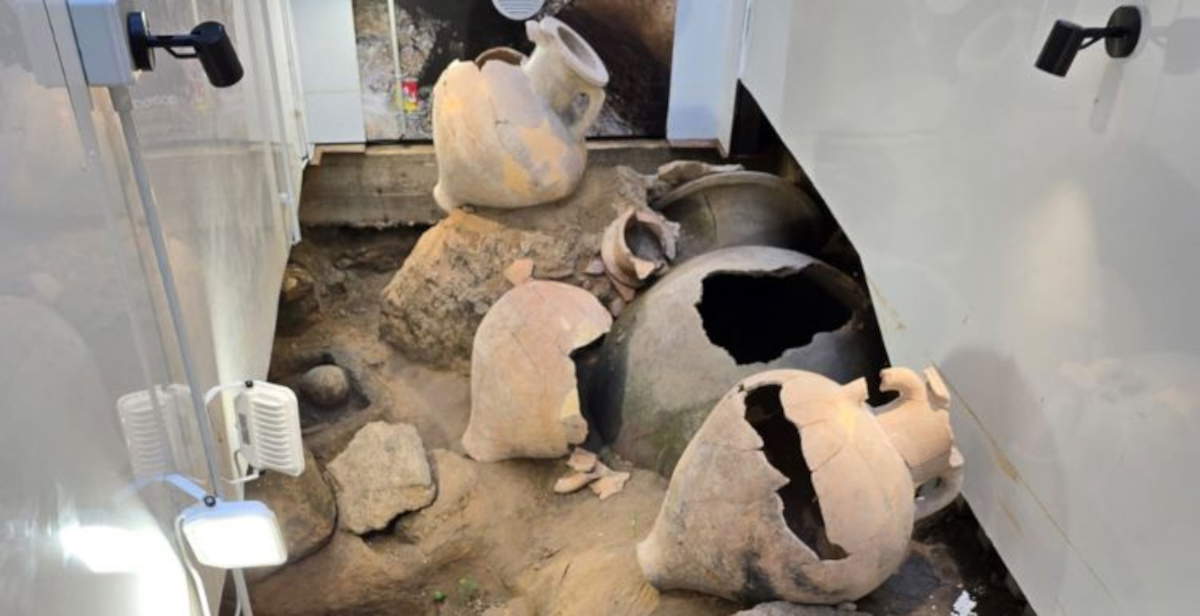A new open-air museum has been inaugurated in the historic center of Gela, set up in Via Di Bartolo, at the area where a Greek necropolis from the Archaic period emerged during excavations for the laying of fiber optics. The archaeological site, dating back to the 6th century B.C., was identified thanks to preventive archaeology activities initiated during infrastructure work carried out by Open Fiber. The discovery led to the design and implementation of an enhancement intervention that made the unearthed section, now visible through a large walkable glass slab integrated into the road surface, usable.
“An extraordinary discovery,” said the councilor for cultural heritage and Sicilian identity, Francesco Paolo Scarpinato, “which has transformed an infrastructural construction site into a unique opportunity to enhance the city’s historical heritage. An archaeological excellence emerged in a totally unexpected way, which gives us back valuable information about the foundation of Gela and the daily life of its first Greek settlers. The transformation of this necropolis into an open-air museum in the heart of the city is a virtuous example of how protection, research and innovation can coexist and reinforce each other. Sicily continues to reveal its past, offering it as a shared heritage to the community.”

“Once again,” said Daniela Vullo, superintendent of Cultural Heritage of Caltanissetta, “preventive archaeology activities in Gela have produced extraordinary results. The musealization of the necropolis of Via Bartolo marks a new path in the enhancement of the territory’s archaeological heritage.”
The initiative, financed entirely by Open Fiber, was carried out under the scientific direction of the Caltanissetta Superintendency of Cultural Heritage, which oversaw the archaeological operations and defined the methods of conservation and use of the site. The area was pedestrianized to ensure protection and safe access for visitors, without compromising the integrity of the funerary context. The excavation uncovered an intact segment of the necropolis, including sixteen burials distributed on two levels. The typology of the graves and the composition of the anthropological sample have returned an accurate picture of the funerary practices of the period. In particular, it is a small cemetery sector with a relevant presence of infant graves, including those “a enchytrismós,” a form of burial reserved for very young children, laid inside amphorae then buried.
The most striking element, according to archaeologists, is precisely the high concentration of pediatric burials, which could suggest the existence of a funerary space used by a single family or a small social nucleus. Anthropological data obtained from the skeletal remains indicate the presence of one adult about 35 years old, two adolescents, four infants and one child about three years old. The mode of burial and the few grave goods found speak of sober rites, but not without symbolic elements.

Of particular importance is tomb number 10, inside which a small ceramic spinning top was found, surprisingly similar to those still in use today. An object that could be interpreted as a simple game, but according to experts takes on a deeper meaning, evoking the brevity of human existence. The spinning top, in this context, becomes a metaphor for the fleeting nature of life and the transition between childhood and death. In addition to the enchytrismós burials, a tomb with a large “pithos” (a large jar), four terracotta tombs, five with Corinthian amphorae datable to the first half of the sixth century B.C., two cinerary urns and other remains referable to incineration practices were found. The variety of funerary types documents a certain complexity in the management of rituals, with mixed forms including both inhumation and cremation.
The open-air museum created on Di Bartolo Street is designed to offer an immediate but scientifically rigorous reading of the site. The transparent glass installation allows passersby and visitors to observe the arrangement of the tombs in their original location, without compromising the preservation conditions. The intervention was designed to integrate the new exhibition space into the existing urban fabric, helping to restore centrality to the history of the city of Gela, one of the oldest Greek colonies in Sicily.
 |
| Gela, open-air museum opens with Greek tombs discovered on Di Bartolo Street |
Warning: the translation into English of the original Italian article was created using automatic tools. We undertake to review all articles, but we do not guarantee the total absence of inaccuracies in the translation due to the program. You can find the original by clicking on the ITA button. If you find any mistake,please contact us.